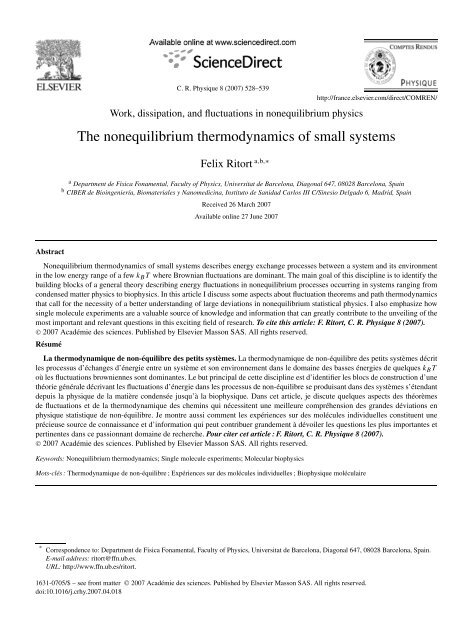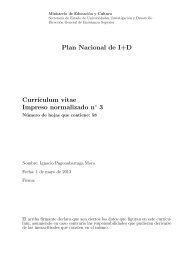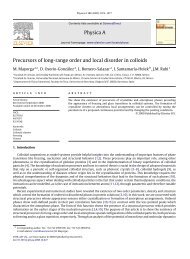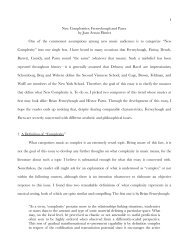The nonequilibrium thermodynamics of small systems
The nonequilibrium thermodynamics of small systems
The nonequilibrium thermodynamics of small systems
You also want an ePaper? Increase the reach of your titles
YUMPU automatically turns print PDFs into web optimized ePapers that Google loves.
F. Ritort / C. R. Physique 8 (2007) 528–539 531dissipation in irreversible processes is then related to the asymmetry between the phase space densities obtained whenthe process is run forward and backward in time [13].Several results known under the generic name <strong>of</strong> fluctuation theorems (FTs) have been recently developed that putmore stringent conditions on the spectrum <strong>of</strong> work fluctuations in a <strong>nonequilibrium</strong> experiment, the second law beingjust a particular consequence <strong>of</strong> such results [14–21]. Prominent examples are the <strong>nonequilibrium</strong> work equality byJarzynski [22] and the fluctuation relation by Crooks [23,24] that allow one to recover free energy differences frommeasurements <strong>of</strong> the irreversible work along <strong>nonequilibrium</strong> processes. <strong>The</strong>se relations have been demonstrated undera few assumptions and for a large variety <strong>of</strong> <strong>nonequilibrium</strong> theories and solvable models (see for instance [25,26]).<strong>The</strong>y read,(exp− W dissT)(= 1 or exp − W ) (= exp − FTT)(P F (W diss )P R (−W diss ) = exp WdissTor)(P F (W ) W − FP R (−W) = exp TIn (2) the P F (W ), P R (W ) denote the forward and reverse work distributions corresponding to the forward and reverseprocesses (time reversed images <strong>of</strong> each other). <strong>The</strong> Crooks relation (2) provides a way to determine free energydifferences from measurements <strong>of</strong> the irreversible work by looking at the work value where forward and reverse workdistributions cross each other. According to (2), P F (W = F ) = P R (−W =−F ).<strong>The</strong> second law <strong>of</strong> <strong>thermodynamics</strong>, W F , also follows naturally as a particular case <strong>of</strong> (1) by using the convexityinequality, exp(x) exp x. Gaussian work distributions exactly satisfy (2) provided the average dissipated workW diss and the variance <strong>of</strong> the work, σ 2 W , are identical along the forward and reverse processes and σ 2 W = 2k BT W diss .A fluctuation–dissipation parameter R can be introduced to quantify deviations from the Gaussian behavior [27],σW2 R =(3)2k B T W dissFor Gaussian work distributions R = 1, corresponding to <strong>nonequilibrium</strong> processes in the linear regime where thefluctuation–dissipation theorem holds.3.2. Path <strong>thermodynamics</strong>One <strong>of</strong> the consequences <strong>of</strong> (1) is the possibility to define thermodynamic potentials associated to paths or trajectories[28]. We define the path entropy S(W) as the logarithm <strong>of</strong> the density <strong>of</strong> paths with work equal to W ,P(W)= exp(S(W )). Eq. (1) can be rewritten as,(exp− FT)= ∑ Γ∫=(exp − W(Γ) ) ∫=T(dW exp S(W) − W T)(dW P(W)exp − W )T) ∫ (= dW exp − Φ(W) )Twhere Γ denotes an arbitrary path and Φ(W) = W − TS(W) is the path free energy. In the large volume limit thesum in (4) is dominated by the work value, W † , where Φ(W) is minimum. We note from (4) that the path free energyΦ(W † ) is equal to the free energy difference F . <strong>The</strong> following chain <strong>of</strong> relations hold,F = Φ ( W †) = W † − TS ( W †) (5)( )( )∂Φ(W)∂S(W)= 0 →= 1 (6)∂W W =W † ∂W W =W † TAt the same time, W † is different from the most probable work, W mp , defined as the work value at which S(W) ismaximum,( )( )∂S(W)∂Φ(W)= 0 →= 1 (7)∂W W =W mp ∂W W =W mp(1)(2)(4)
534 F. Ritort / C. R. Physique 8 (2007) 528–539and from this result we obtain the path entropy,S(W) = log ( P(W) ) =− Tk ( ( ) )0 W2μr log exp + 1 + W ( ( )) WT 2T − log cosh + constant (20)2TIt is important to stress that (19) does not satisfy (2) (with P F (W ) = P R (W )) except in the limit r →∞where thisapproximation becomes exact. We now consider the large r limit. For W mp ,W † we obtain to the leading order,S ′( W mp) ( ) ( )2μr 1= 0 → W mp = T log + O(21)k 0 T rS ′( W †) = 1 ( ) ( )2μr 1T → W † =−T log + O(22)k 0 T rso the symmetry (10) (or (11)) is satisfied to the leading order in r (yet it can be shown that the 1/r corrections appearingin W mp ,W † (21), (22) are different). <strong>The</strong> logarithmic increase <strong>of</strong> the average work with the ramping speed (21)is just a consequence <strong>of</strong> the logarithmic increase <strong>of</strong> the average value <strong>of</strong> the switching field H ∗ with the rampingspeed. This result has been also found for the dependence <strong>of</strong> the average breakage force <strong>of</strong> molecular bonds in singlemolecule pulling experiments. This phenomenology, related to the technique commonly known as dynamic forcespectroscopy, allows to explore free energy landscapes by varying the pulling speed over several orders <strong>of</strong> magnitude[34,35].3.4. Large work/heat deviations<strong>The</strong> work distribution obtained in the previous example (hereafter we use q = Q = W ) shows the presence <strong>of</strong> largework/heat tails. For |q|→∞we get,s(q →∞) =− qk ( (02μr + O exp − q ))(23)Ts(q →−∞) = q ( )) q(expT + O (24)T<strong>The</strong> linear dependence <strong>of</strong> s(q) on q leads toˆT(q→∞) = T − =− 2μr(25)k 0ˆT(q→−∞) = T + = T (26)where we use the notation T + ,T − to stress the fact that these path temperatures are positive and negative respectively.Both path temperatures are constant and lead to exponential tails for positive and negative work values. Note thatEq. (9) reads,s(q) − s(−q) = q T → (s)′ (q) + (s) ′ (−q) = 1 T → 1T + + 1T − = 1 (27)Twhich is satisfied by (25), (26) up to 1/r corrections. Fig. 3 shows the results obtained for the path entropy, free energyand temperature using a mean-field path integral formalism that includes arbitrary paths with more than one reversal<strong>of</strong> the dipole (for details <strong>of</strong> the computations see [28,30]). A more detailed analysis [31] has shown that a plateau isnever fully reached for a finite interval <strong>of</strong> heat values when r → 0. <strong>The</strong> presence <strong>of</strong> a plateau has been interpreted interms <strong>of</strong> a first order phase transition appearing in the path entropy s(q) [31].<strong>The</strong> path entropy s(w) contains two fluctuation sectors [2] (see also [36] for a discussion <strong>of</strong> these sectors in thecontext <strong>of</strong> oscillator models for glassy dynamics):– <strong>The</strong> FDT or stimulated sector: This sector is described by Gaussian work fluctuations leading to s(q) =−(q −q mp ) 2 /(2σq 2 1)+constant. <strong>The</strong>refore we get, from (8), λ(q) =ˆT(q) =−q−qmp showing a linear dependence in q forσq2<strong>small</strong> deviations around q mp . Note that ˆT(q) satisfies (27) and therefore σq 2 = 2Tqmp , leading to a fluctuationdissipationparameter R = 1 (3). This sector we call stimulated because the magnitude <strong>of</strong> heat fluctuations isgoverned by the temperature <strong>of</strong> the bath.
F. Ritort / C. R. Physique 8 (2007) 528–539 535Fig. 3. (A) Heat distributions (path entropy s(q) and path free energy f(q)) evaluated at four values <strong>of</strong> increasing ramping speeds (from the mostnarrower to the most wider distributions). <strong>The</strong> dashed line in the left panel is y(q) = q/T (we take T = 1) and is tangent to s(q) at q † (filled dotsshown for the largest ramping speed). <strong>The</strong> dashed line in the right panel corresponds to y(q) = q and is tangent to the function f(q)at the valueq mp (filled dots are shown for the largest speed). (B) λ(q) for the lowest speed. It shows a linear behavior for <strong>small</strong> values <strong>of</strong> q (dotted line). Figureadapted from [28].– <strong>The</strong> large deviation or spontaneous sector: Under some conditions this sector is well reproduced by exponentialtails in the work distribution describing large or macroscopic deviations. In this sector,1ˆT(q) − 1ˆT(−q) = 1 T → 1T + + 1T − = 1 T(28)<strong>The</strong> physical interpretation <strong>of</strong> T + ,T − is as follows. Because T − < 0 then T − describes fluctuations (correspondingto q positive and large (25)) where net heat is released from the system to the bath, whereas T + > 0 describesfluctuations (corresponding to q negative and large (26)) where the system absorbs a net amount <strong>of</strong> heat fromthe bath. Eq. (28) imposes T + < |T − | implying that large deviations also satisfy the second law: the averagenet amount <strong>of</strong> heat supplied to the bath (∝ |T − |) is always larger that the average net heat absorbed from thebath (∝ T + ). In the previous example (25), (26), T + converges to the bath temperature whereas T − divergesto −∞ when r →∞. We call this sector spontaneous because the energy fluctuations mainly depend on the<strong>nonequilibrium</strong> protocol (in the present example, such dependence is contained in the r-dependence <strong>of</strong> T − , (25)).4. Free energy recovery in single molecule experimentsSingle molecule force experiments [5] using optical tweezers have provided some <strong>of</strong> the first experimental tests<strong>of</strong> fluctuation theorems. <strong>The</strong> basis <strong>of</strong> single force measurements is to use a local probe (a cantilever in AFM, a glassbead in optical tweezers, a magnetic bead in magnetic tweezers, etc.) to detect forces in the pN range. <strong>The</strong> sensitivityin force and extension <strong>of</strong> these probes is limited by Brownian fluctuations which put upper bounds to the resolution<strong>of</strong> the instrument. In general, force and extension sensitivity are determined by the magnitude <strong>of</strong> the fluctuationsf ∼ √ k B Tkand x ∼ √ k B T/kwhere k is the effective stiffness or rigidity <strong>of</strong> the probe (a combination the stiffness<strong>of</strong> the probe and the stiffness <strong>of</strong> the molecular system that is manipulated). A large value <strong>of</strong> k implies high spatialresolution but low force resolution (a good example is the AFM which due to its high spatial resolution is also usedas an imaging tool) whereas at low k values we have low spatial but high force resolution (e.g. magnetic tweezers). Ingeneral, f x ∼ k B T and accuracies in both quantities appear to be complementary, a sort <strong>of</strong> uncertainty principle.Optical tweezers <strong>of</strong>fer a good balance between both limiting cases with f and x both reasonably <strong>small</strong> (in the0.1 pN and 1 Å ranges respectively).Optical tweezers are based on the optical gradient force discovered by Ashkin in 1970. By focusing an infraredlaser beam (to avoid heating effects in water) and using a water or oil immersed objective with high numerical aperture
536 F. Ritort / C. R. Physique 8 (2007) 528–539Fig. 4. Three RNA molecules: CD4, a canonical hairpin (left); S15, a three way junction (center); and a subunit <strong>of</strong> ribosomal RNA in E. coli (right).FTs have been tested in the first two molecules.(in the range 1.2–1.4) it is possible to trap micron sized beads having an index <strong>of</strong> refraction higher than that <strong>of</strong> water(e.g. <strong>of</strong> polystyrene or silica beads). In order to reduce the scattering force along the optical axis it is useful to buildoptical tweezers with counter propagating laser beams. In this setup it is then possible to use objectives with numericalaperture in the lower range (≃1.2) and, at the same time, collect all the deflected light by the bead. This allows tomeasure the transverse and axial components <strong>of</strong> the force acting on the bead by using position sensitive detectorslocated at opposite sides <strong>of</strong> each laser beam.Over the past years RNA has been investigated using optical tweezers. <strong>The</strong>re are several reasons that make RNAa good model system to investigate <strong>nonequilibrium</strong> fluctuations in <strong>small</strong> <strong>systems</strong>. RNA is a very important player inmolecular biology that shows biological functions in between those attributed to DNA and proteins. For the biophysicistand the statistical physicist RNA is also a fascinating molecule. Primarily found in nature in single stranded form,RNA folds into a three dimensional structure mainly stabilized by stacking interactions and hydrogen bonds betweencomplementary bases (A-U,G-C). Full complementarity between different RNA segments is <strong>of</strong>ten impossible so, atdifference with DNA, RNA structure also includes mismatches between bases as well other structural defects (bulges,loops, junctions, ...). In addition to Watson-Crick base pairing, RNA forms a compact structure through specific interactionsmediated by magnesium ions that bring together distal RNA segments. A few structures where FTs have beentested are shown in Fig. 4. Another aspect that makes RNA particularly interesting, at difference with proteins, is itsmodular structure (Fig. 4). This fact makes RNA particularly suited to investigate questions related to the folding <strong>of</strong>biomolecules. How does RNA fold? Does folding occur majoritarily in one big step where all domains are simultaneouslystabilized and the entropy <strong>of</strong> formation is suddenly released as heat to the environment? Or, instead, does foldingoccur in a series <strong>of</strong> steps, where at each step a few kcal per mol are dissipated to the environment? Understanding theprocess by which molecules dissipate energy while they fold may shed light on the physical mechanisms behind theselection <strong>of</strong> specific molecular structures during evolution.RNA molecules can be manipulated using optical tweezers and the folding/unfolding kinetics investigated undermechanical force [37]. From the force extension curves it is then possible to measure the work done upon/by the moleculeby/on the instrument [38]. In order to pull RNA molecules it is useful to insert them between double strandedDNA/RNA hybrid handles that provide the necessary space between the micron sized beads to carry out the manipulation(Fig. 5A). <strong>The</strong> whole molecular construct (RNA plus handles) can be synthesized using standard gene cloning
F. Ritort / C. R. Physique 8 (2007) 528–539 537Fig. 5. (A) Experimental setup in RNA force pulling experiments. (B) Force-extension curves in the canonical hairpin CD4 showing the workintegration range. (C) Unfolding/refolding work distributions measured at three pulling speeds. (D) Verification <strong>of</strong> the Crooks FT. Results takenfrom [39].and PCR techniques. In such experiments RNA molecules can be repeatedly pulled and relaxed to produce unfoldingand refolding force-extension curves such as those shown in Fig. 5B for the canonical hairpin CD4. By measuring thearea under the curve it is then possible to estimate the work done on/by the molecule along each unfolding/refoldingpath. Work distributions for different molecules and different speeds are shown in Fig. 5C and the test <strong>of</strong> the FTin Fig. 5D. As predicted by the FT (3), work distributions cross at the same value <strong>of</strong> the work for all three pullingspeeds. From this value we can extract the free energy <strong>of</strong> formation <strong>of</strong> the hairpin, F , after subtracting the elasticcontributions due to the handles and the ssRNA. <strong>The</strong> canonical hairpin does not show too irreversible behavior at thepulling speeds investigated (around 100 nm/s) and dissipated work values are not big (around 6k B T at 500 nm/s). Incontrast, the force–extension curves for the three way junction S15 shown in Fig. 6 show strong irreversibility effects(e.g. hysteresis) as expected for a larger molecule. S15 unfolds in a cooperative way but refolds less cooperatively andover longer timescales. <strong>The</strong> amount <strong>of</strong> dissipated work is much larger (around 50k B T for the unfolding and around 20k B T during the refolding). <strong>The</strong> FT has been experimentally verified in the case <strong>of</strong> a mutant <strong>of</strong> S15 (differing from thewild type in a single base pair) that folds faster than the wild type. Forward and reverse distributions cross at values <strong>of</strong>F that differ in 3k B T which is equal to the difference in free energy <strong>of</strong> formation between the mutant and the wildtype.5. Conclusions<strong>The</strong> experimental and theoretical study <strong>of</strong> <strong>nonequilibrium</strong> <strong>small</strong> <strong>systems</strong> <strong>of</strong>fers exciting possibilities for the statisticalphysicist and the biophysicist. This discipline aims to describe the novel properties observed in biomolecules
538 F. Ritort / C. R. Physique 8 (2007) 528–539Fig. 6. (Left) Force-extension curves in the three way junction S15 (wild type). (Right) Work distributions measured for the wild type and a mutantdiffering in one base pair swap (GC → CG) located in the stem just below the junction. In the inset we show the experimental verification <strong>of</strong> theCrooks FT. Results taken from [39].and molecular machines operating far from equilibrium, such as the folding <strong>of</strong> a nucleic acid or a protein or thetranslocation motion <strong>of</strong> a molecular motor.We are just starting to take a glance at how these <strong>small</strong> objects exchange energy with their environment. It is a wellknown fact in molecular biology and biochemistry that biological function at the molecular level is tightly related tostructure. It might not be surprising that the link between molecular structure and biological function is encoded inthe low frequency region <strong>of</strong> the spectrum <strong>of</strong> <strong>nonequilibrium</strong> energy fluctuations (the spectrum <strong>of</strong> energy fluctuationsextending far at the most extreme tails <strong>of</strong> the distribution). It is difficult to imagine how biomolecular processes, <strong>of</strong>tencarrying a lot <strong>of</strong> information, can operate solely from high frequency events describing the motion <strong>of</strong> a few number<strong>of</strong> atoms. Rather, these should somehow rely on the low frequency cooperative motion between different and distantparts <strong>of</strong> the molecule. In other words, <strong>nonequilibrium</strong> fluctuations that drive biological function must be encodedin the tails <strong>of</strong> the energy exchange distribution, what we have called the spontaneous sector here and in previousworks (see [2] for a review). Investigating the spontaneous sector <strong>of</strong> fluctuations in <strong>nonequilibrium</strong> <strong>systems</strong> calls for adeeper theoretical understanding <strong>of</strong> large deviation functions in <strong>nonequilibrium</strong> <strong>systems</strong> (see for instance [40]) as wellas more systematic and accurate experiments identifying sources <strong>of</strong> large energy fluctuations in biological <strong>systems</strong>.We are at the dawn <strong>of</strong> an interdisciplinary scientific discipline that will bring together scientists with expertisescoming from very different branches <strong>of</strong> knowledge. This merging process might culminate with the future engineering<strong>of</strong> artificial mesoscopic structures capable <strong>of</strong> reproducing and even improving the behavior <strong>of</strong> the biological ones.AcknowledgementsI acknowledge financial support from the Ministerio de Eduación y Ciencia (Grant FIS2004-3454 and NAN2004-09348) and the Catalan government (Grant SGR05-00688).References[1] C. Bustamante, J. Liphardt, F. Ritort, <strong>The</strong> <strong>nonequilibrium</strong> <strong>thermodynamics</strong> <strong>of</strong> <strong>small</strong> <strong>systems</strong>, Physics Today 58 (2005) 43–48.[2] F. Ritort, Nonequilibrium fluctuations in <strong>small</strong> <strong>systems</strong>: From physics to biology, Advances in Chemical Physics 137 (2007), in press.[3] J. Howard, Mechanics <strong>of</strong> Motor Proteins and the Cytoskeleton, Sinauer, Sunderland, MA, 2001.[4] R.D. Astumian, <strong>The</strong>rmodynamics and kinetics <strong>of</strong> a Brownian motor, Science 276 (1997) 917–922.[5] F. Ritort, Single molecule experiments in biological physics: methods and applications, Journal <strong>of</strong> Physics (Condensed Matter) 18 (2006)R531–R583.[6] C.K. Mathews, K.E. van Holde, K.G. Ahern, Biochemistry, Addison–Wesley Publishing Company, 2000.[7] H. Wang, G. Oster, <strong>The</strong> Stokes efficiency for molecular motors and its applications, Europhysics Letters 57 (2002) 134–140.
F. Ritort / C. R. Physique 8 (2007) 528–539 539[8] C. Bustamante, Y.R. Chemla, N.R. Forde, D. Izhaky, Mechanical processes in biochemistry, Annual Reviews <strong>of</strong> Biochemistry 73 (2004)705–748.[9] H. Yin, M.D. Wang, K. Svoboda, R. Landick, S.M. Block, J. Gelles, Transcription against an applied force, Science 270 (1995) 1653–1657.[10] M.D. Wang, M.J. Schnitzer, H. Yin, R. Landick, J. Gelles, S.M. Block, Force and velocity measured for single molecules <strong>of</strong> RNA polymerase,Science 282 (1998) 902–907.[11] R.J. Davenport, G.J. Wuite, R. Landick, C. Bustamante, Single-molecule study <strong>of</strong> transcriptional pausing and arrest by E. coli RNA polymerase,Science 287 (2000) 2497–2500.[12] N.R. Forde, D. Izhaky, G.R. Woodcock, G.J.L. Wuite, C. Bustamante, Using mechanical force to probe the mechanism <strong>of</strong> pausing and arrestduring continuous elongation by Escherichia coli RNA polymerase, Proceedings <strong>of</strong> the National Academy <strong>of</strong> Sciences 99 (2002) 11682–11687.[13] R. Kawai, J.M.R. Parrondo, C.V. den Broeck, Dissipation: the phase-space perspective, Physical Review Letters 98 (2007) 080602.[14] D.J. Evans, D.J. Searles, Equilibrium microstates which generate second law violating steady-states, Physical Review E 50 (1994) 1645–1648.[15] E.G.D. Cohen, D.J. Evans, G.P. Morriss, Probability <strong>of</strong> second law violations in shearing steady states, Physical Review Letters 71 (1993)2401–2404.[16] G. Gallavotti, E.G.D. Cohen, Dynamical ensembles in <strong>nonequilibrium</strong> statistical mechanics, Physical Review Letters 74 (1995) 2694–2697.[17] J. Kurchan, Fluctuation theorem for stochastic dynamics, Journal <strong>of</strong> Physics A 31 (1998) 3719–3729.[18] J.L. Lebowitz, H. Spohn, A Gallavotti–Cohen type symmetry in the large deviation functional for stochastic dynamics, Journal <strong>of</strong> StatisticalPhysics 95 (1999) 333–365.[19] C. Maes, <strong>The</strong> fluctuation theorem as a Gibbs property, Journal <strong>of</strong> Statistical Physics 95 (1999) 367–392.[20] P. Gaspard, Fluctuation theorem for <strong>nonequilibrium</strong> reactions, Journal <strong>of</strong> Chemical Physics 120 (2004) 8898–8905.[21] U. Seifert, Entropy production along a stochastic trajectory and an integral fluctuation theorem, Physical Review Letters 95 (2005) 040602.[22] C. Jarzynski, Nonequilibrium equality for free-energy differences, Physical Review Letters 78 (1997) 2690–2693.[23] G.E. Crooks, Entropy production fluctuation theorem and the <strong>nonequilibrium</strong> work relation for free-energy differences, Physical Review E 60(1999) 2721–2726.[24] G.E. Crooks, Path-ensemble averages in <strong>systems</strong> driven far from equilibrium, Physical Review E 61 (2000) 2361–2366.[25] D. Astumian, Equilibrium theory for a particle pulled by a moving optical trap, Journal <strong>of</strong> Chemical Physics 126 (2007) 111102.[26] B. Cleuren, C. Van den Broeck, R. Kawai, Fluctuation and dissipation <strong>of</strong> work in a Joule experiment, Physical Review Letters 96 (2006)050601.[27] F. Ritort, C. Bustamante, I. Tinoco Jr, A two-state kinetic model for the unfolding <strong>of</strong> single molecules by mechanical force, Proceedings <strong>of</strong>the National Academy <strong>of</strong> Sciences 99 (2002) 13544–13548.[28] F. Ritort, Work and heat fluctuations in two-state <strong>systems</strong>: a trajectory <strong>thermodynamics</strong> formalism, Journal <strong>of</strong> Statistical Mechanics (<strong>The</strong>or.Exp.) (2004) P10016.[29] C. Jarzynski, Rare events and the convergence <strong>of</strong> exponentially averaged work values, Physical Review E 73 (2006) 046105.[30] A. Imparato, L. Peliti, Work distribution and path integrals in mean-field <strong>systems</strong>, Europhysics Letters 70 (2005) 740–746.[31] A. Imparato, L. Peliti, Work probability distribution in <strong>systems</strong> driven out <strong>of</strong> equilibrium, Physical Review E 72 (2005) 046114.[32] P. Hanggi, P. Talkner, M. Borkovec, Reaction-rate theory: fifty years after Kramers, Review <strong>of</strong> Modern Physics 62 (1990) 251–341.[33] V.I. Melnikov, <strong>The</strong> Kramers problem: fifty years <strong>of</strong> development, Physics Reports 209 (1991) 1–71.[34] E. Evans, Probing the relationship between force—lifetime—and chemistry in single molecular bonds, Annual Reviews <strong>of</strong> Biophysics andBiomolecular Structure 30 (2001) 105–128.[35] E. Evans, P. Williams, Dynamic force spectroscopy, in: H. Flyvbjerg, F. Jülicher, P. Ormos, F. David (Eds.), Physics <strong>of</strong> Biomolecules andCells, vol. LXXV, Springer-Verlag, Berlin, 2002, pp. 145–204.[36] F. Ritort, Spontaneous relaxation in generalized models for glassy dynamics, Journal <strong>of</strong> Physical Chemistry B 108 (2004) 6893–6900.[37] J. Liphardt, B. Onoa, S.B. Smith, I. Tinoco Jr, C. Bustamante, Reversible unfolding <strong>of</strong> single RNA molecules by mechanical force, Science 292(2001) 733–737.[38] J. Liphardt, S. Dumont, S.B. Smith, I. Tinoco Jr, C. Bustamante, Equilibrium information from <strong>nonequilibrium</strong> measurements in an experimentaltest <strong>of</strong> the Jarzynski equality, Science 296 (2002) 1833–1835.[39] D. Collin, F. Ritort, C. Jarzynski, S.B. Smith, I. Tinoco Jr, C. Bustamante, Verification <strong>of</strong> the Crooks fluctuation theorem and recovery <strong>of</strong> RNAfolding free energies, Nature 437 (2005) 231–234.[40] B. Derrida, J.L. Lebowitz, E.R. Speer, Free energy functional for <strong>nonequilibrium</strong> <strong>systems</strong>: an exactly solvable case, Physical Review Letters 87(2001) 150601.





